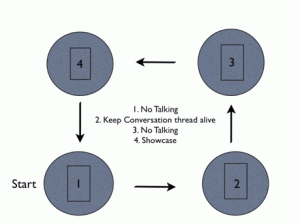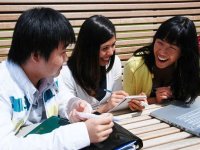Building Classroom Community Amongst the Machines
There’s no denying that most of us are engrossed daily with technology. The attachment is evident in just about every public place. Mobile devices, for many of us, have become our closest friend. In April, the Telegraph reported on toddlers becoming so addicted to their iPads that they required therapy. While this is an extreme case, it's not too far from reality. The mobile device has become our community hub. It's where we go for information and to socialize. It's the new water cooler. In short, our most intimate relationship is with a machine.
In my observations both inside and outside the classroom, I've noticed the relationship with the device to be the most prevalent. This is not to say that teachers are no longer connecting with students, but the devices seem to take precedence. Walk down any city street or attend any event, and you'll notice this intimate relationship taking place; head tilted down and thumbs vigorously moving. Sherry Turkle highlights this new environment in her book Alone Together and addresses it in her TED talk. Turkle articulates the oxymoron of being isolated yet thinly connected to a large group of people. It's a strange concept, but one that should cause us all to pause and consider our online and offline relationships. We have the ability to connect with the world like never before, but are we really making meaningful connections?
And while technology will continue to integrate into societies and classrooms around the globe, how do we, as educators, build a classroom community comprised of meaningful relationships that can coexist with a device? How do we build classroom community amongst the machines?
"Friend" as Noun Instead of Verb
The answer lies in how the teacher decides to embrace new technologies without allowing them to fill in for or take the place of personal relationships. While this may seem challenging in today's connected classroom, being a flexible teacher is key to building a strong community. It requires balance and patience not to rush into technology just because technology is available. It prompts teachers to consider how the physical space can be used as a vehicle for building a community. Ultimately, creating a classroom community demands that the teacher facilitate this process.
To start, many may think that the obvious choice for building a community is a robust learning management system (LMS). While an LMS is a great tool for creating efficient workflows and organizing a classroom, it really builds a wall between the student and teacher. What's more, diving straight into an LMS produces an assembly line feeling in your classroom. Most of the students and teachers I talk to feel that it's a burden to read through a discussion thread and respond. Similarly, these same students and teachers also express a sense of being alone even though they are connected. The relationships are thin and practically non-existent, yet the feeling of connectedness is present. If you've ever taken an online or virtual course, you can probably relate to these sentiments. But how many of you remember the classmates or colleagues who were in that online course with you? I'd venture to say those personalities are lost.
Understanding what the qualities of a strong community are -- beyond the technology -- is where all teachers should begin. The technology will come and eventually foster established relationships. These offline skill sets are extremely important to address at the elementary level. Students thrust too quickly into digital spaces may not ever come back, nor will they know a world outside of these digital spaces. Their sense of community and interaction will be diluted and at times seem artificial. Students, especially young students, should know what it means to have a meaningful offline relationship or friend before they have an online friend. Discerning between a best friend who lives down the street and 4,000 "friends" who live online is a difficult concept to grasp at a young age, and even older kids struggle with it. Therefore, teachers should help make this distinction early so that each student can understand and successfully function as a citizen in both digital and non-digital communities.
Community and Communication
Offline community building can be introduced in a variety of ways. I am going to give you a few to start, and I'd love to hear examples that you have used in the comments section of this post.
1. Discussion Thread
This lesson or ice-breaker is one of my favorite ways of introducing a variety of online and social media skill sets without any technology present. Ken Rodoff introduced me to this simulation. The setup consists of four to five tables, and each table contains a large piece of easel paper and several markers. Before your students arrive to class, draw a circle in the middle of each piece of easel paper and in the center of that circle put a word or phrase. This word or phrase can be anything you want and should be something that will spark a conversation or debate. When the students arrive, prompt them to hover around a table and remain silent. The objective is to have a conversation without saying a word. The second rule is that students must keep the conversation on paper alive. Each student will draw a line from the original word/phrase-in-a-circle and add his or her thoughts. They can also add to another student's circle and continue the conversation (much like an online discussion board, blog comments or a Facebook wall). Give each group three to five minutes to compose their thoughts and respond to others. Then students rotate to the next table. They review what the previous group posted and add to it. Students will rotate in this manner until they return to their original table. Have one student from each group hang their easel paper on the wall and allow time for the students to collectively review the different conversation threads.

2. Personal Maker Space
This idea comes directly from Edutopia. Before your students arrive to class, place colored pipe cleaners on all of the desks. When students arrive, tell them to take their seats and create something. Again, the most important rule is silence. After about five minutes, pair students up randomly and have each student explain his or her creation to the other. Then, have students connect in fours. The object is sharing each others' creations and discussing the process.
3. Post on my Wall
This idea is derived from John Spencer's Living Facebook Project. During this project, John abstained from Facebook for 40 days and lived out his Facebook experience. I consolidated this project with my digital literacy class last year, but only held them to five days of no Facebook. Have students write something about themselves on your physical wall (dry erase board). Then have them respond to each other's comments as they would on a Facebook wall. Much like the discussion thread posters, have students walk around to observe each other's comments and respond when they want.
Building meaningful, offline relationships is essential to engaging in digital spaces. Students must understand that a friend is not simply a button you click to accept and that a conversation is not always typed into a small box. Technology can do great things for our lives and bring us all closer together; however, it shouldn't isolate us from personal relationships.
